Information Analysts focus on gathering, interpreting, and transforming data into actionable insights to support decision-making processes, while Information Architects design and structure information systems to ensure optimal user experience and efficient data retrieval. Analysts emphasize data analysis and reporting, whereas architects prioritize organizing content and creating intuitive navigation frameworks. Both roles are essential for maximizing an organization's information management and strategic planning capabilities.
Table of Comparison
| Role | Information Analyst | Information Architect |
|---|---|---|
| Primary Focus | Data analysis, interpretation, and reporting | Designing information structure and user navigation |
| Key Responsibilities | Data collection, analysis, trend identification, KPIs | Information hierarchy, taxonomy, wireframes, UX design |
| Skills | Data mining, SQL, statistical tools, reporting | UX design, content strategy, metadata, prototyping |
| Goal | Extract actionable insights from data | Optimize information usability and findability |
| Tools | Excel, Tableau, Power BI, R, Python | Axure, Sketch, Visio, Adobe XD |
| Outcome | Data-driven decisions and performance improvements | Intuitive, efficient information systems and interfaces |
Role Overview: Information Analyst vs Information Architect
An Information Analyst focuses on collecting, analyzing, and interpreting data to support decision-making and optimize business processes. An Information Architect designs and structures information systems, ensuring effective organization, navigation, and accessibility of digital content. Both roles contribute to data management but differ in analytical versus structural responsibilities.
Core Responsibilities and Scope
Information Analysts specialize in collecting, analyzing, and interpreting data to support decision-making processes, focusing primarily on data accuracy, trends, and actionable insights. Information Architects design and organize information structures, ensuring intuitive navigation and efficient content management across digital platforms, emphasizing user experience and information flow. The scope of Information Analysts centers on data analysis and reporting, while Information Architects concentrate on system design and information usability.
Required Skills and Competencies
Information Analysts require strong data analysis, critical thinking, and proficiency in tools like SQL, Excel, and data visualization software to interpret and present data effectively. Information Architects need expertise in user experience (UX) design, information structure, and proficiency with wireframing and prototyping tools such as Axure and Sketch to organize and label digital content intuitively. Both roles demand excellent communication skills and the ability to collaborate with cross-functional teams to align data or structural insights with business goals.
Typical Educational Background
Information Analysts typically hold degrees in information systems, data science, computer science, or business analytics, emphasizing quantitative analysis and data management skills. Information Architects usually have educational backgrounds in information architecture, human-computer interaction, library science, or design, focusing on user experience, content organization, and interface design. Both roles may benefit from certifications in data visualization, usability, or information management to enhance specialized expertise.
Tools and Technologies Utilized
Information Analysts primarily use data visualization tools like Tableau and Power BI, along with SQL for data querying and statistical software such as R or Python for analysis. Information Architects rely on wireframing and prototyping tools like Axure, Sketch, or Adobe XD, coupled with content management systems (CMS) and user experience (UX) design platforms to structure and organize information. Both roles utilize collaboration tools such as Jira and Confluence to facilitate project management and communication across teams.
Key Deliverables and Outputs
Information Analysts primarily deliver insights through data collection, interpretation, and reporting to support business decision-making, emphasizing data accuracy and trend analysis. Information Architects focus on designing information systems, creating optimal data structures, navigation schemes, and metadata frameworks that enhance user experience and content accessibility. Key outputs for Information Analysts include dashboards, analytical reports, and data models, while Information Architects produce wireframes, taxonomies, and site maps to organize and present information effectively.
Collaboration and Interaction with Other Teams
Information Analysts collaborate closely with data scientists, business analysts, and IT teams to interpret data trends and ensure accurate reporting, enhancing decision-making processes. Information Architects work with UX designers, developers, and content strategists to structure digital information environments that improve user navigation and experience. Effective interaction between these roles ensures that data insights are not only accurate but also seamlessly integrated into user-centric digital solutions.
Impact on Organizational Strategy
Information Analysts influence organizational strategy by extracting actionable insights from data, enabling data-driven decision-making and optimizing business processes. Information Architects shape strategy by designing effective information systems and frameworks that improve data accessibility, user experience, and knowledge management. Both roles contribute to strategic alignment, with Analysts focusing on data interpretation and Architects on structuring information flow.
Career Growth and Development Paths
Information Analysts focus on interpreting data to support decision-making, often progressing into roles like data scientist or business intelligence manager, which emphasize analytical and technical skill growth. Information Architects specialize in designing information systems and user experiences, with career paths leading to senior UX strategist or enterprise architect positions, emphasizing design thinking and system organization expertise. Both roles offer strong career development opportunities, but Information Architects tend to evolve towards strategic planning and system design leadership, while Information Analysts advance through data-driven insights and analysis specialization.
Salary Trends and Job Market Demand
Information Analysts typically earn between $60,000 and $85,000 annually, reflecting steady demand in data-driven roles across industries, while Information Architects command higher salaries ranging from $90,000 to $130,000 due to their specialized skill set in designing information systems and user experiences. The job market demand for Information Analysts remains strong as organizations continue to prioritize data analysis for strategic decision-making, whereas Information Architects are increasingly sought after in tech and digital transformation sectors to optimize information flow and usability. Salary trends indicate a growing premium for Information Architects driven by the complexity of their role and the rising emphasis on user-centered design in information management.
Information Analyst vs Information Architect Infographic

 jobdiv.com
jobdiv.com